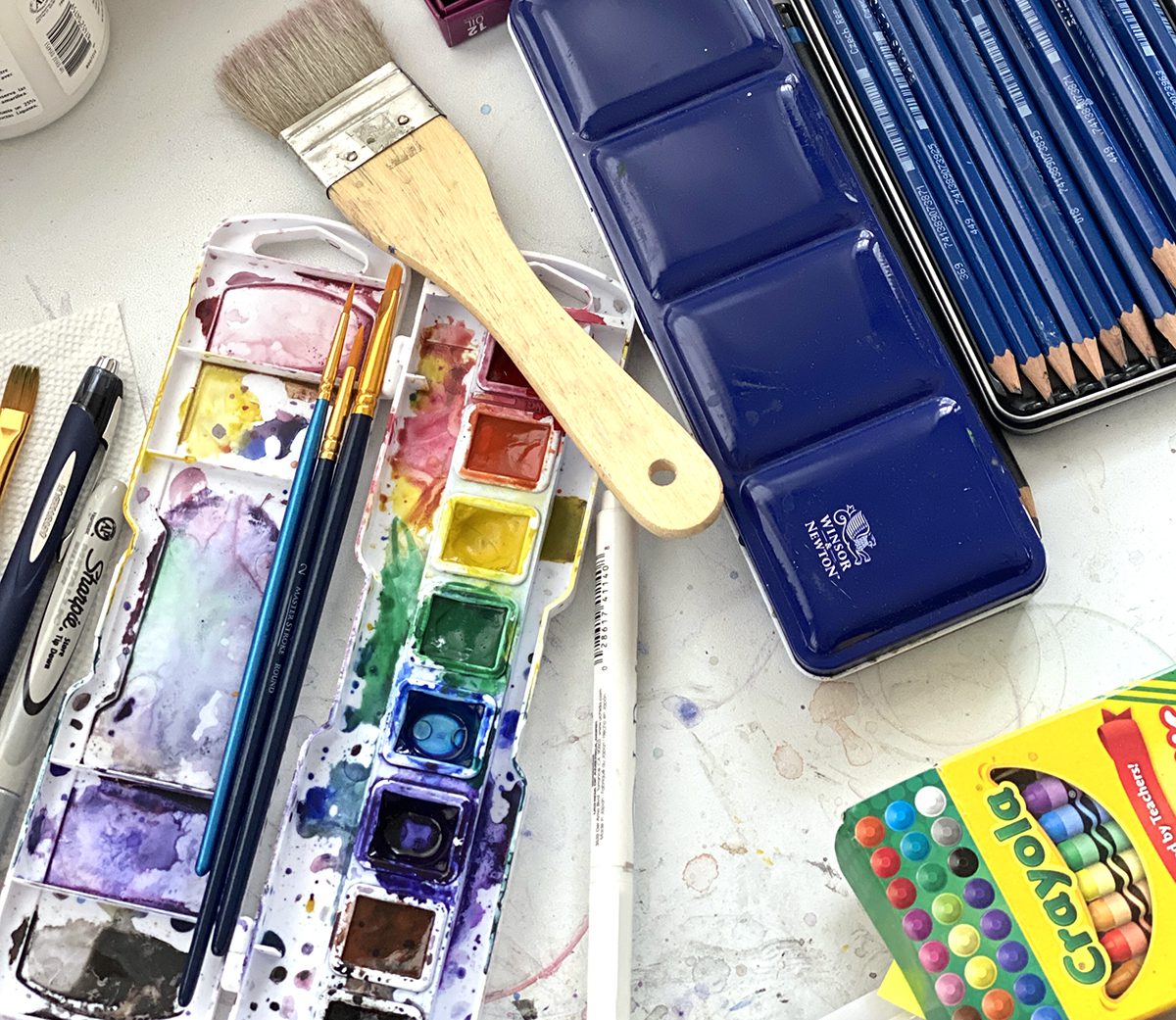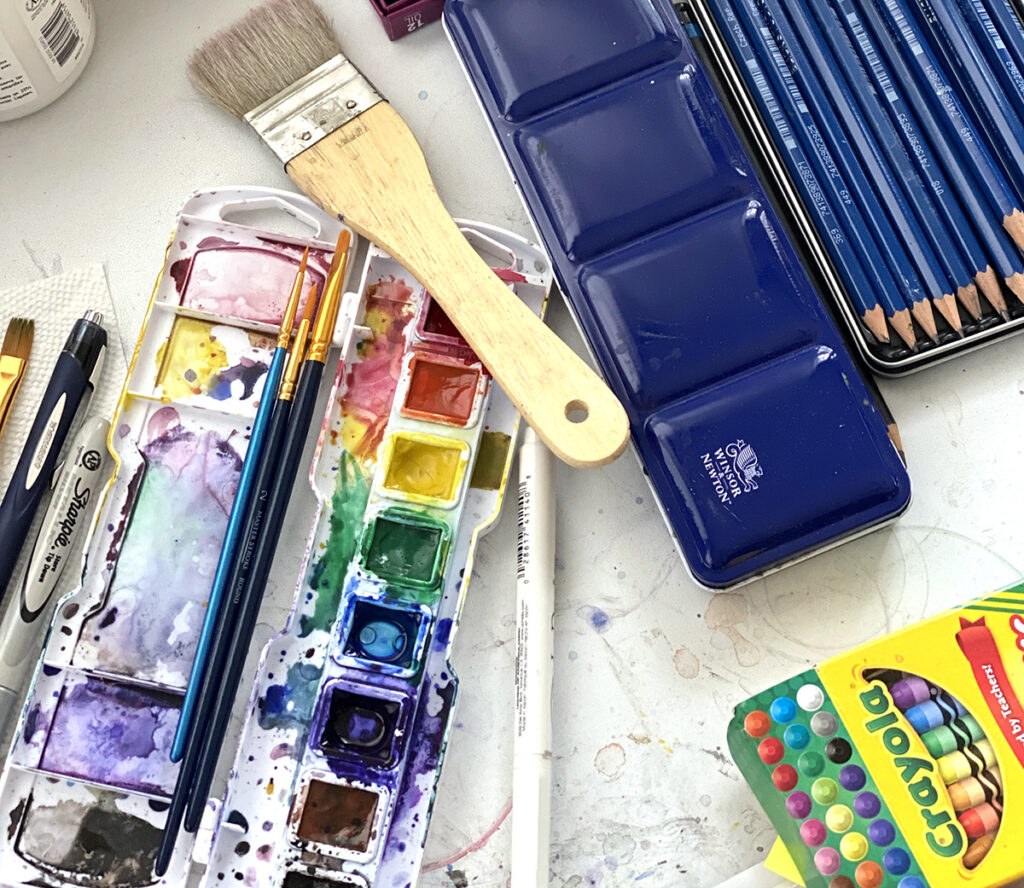Congratulations! You are officially a licensed art teacher! Student teaching may have been challenging, smooth sailing, or somewhere in the middle. Either way, schooling and limited experience can only take you so far. As a veteran teacher working with new teachers and supporting student teachers, there is so much I wish I had known my first year. As you embark on your first year (and years) of teaching, let’s share some real talk.
Here are sixteen key takeaways as you transition into your own classroom.
Before we get started, check out our page specially curated for first-year art teachers. Here, you will find a downloadable guide with free lesson plans and resources for art teachers by art teachers. Find the support you need to navigate your first year in the art room. Watch our YouTube mini-series, First-Year Art Teacher’s Guide, to get tips and tricks from a second-year art teacher, Brittney Witt.
Download the guide now!
1. Curriculum Curation and Creation
When you enter a school, you need to be ready for anything. Some schools may have a well-defined scope and sequence framework. You will need to assess your own lessons or ones you have borrowed to fit within those expectations. Other schools may have no roadmap for you to work from. In this case, you may be excited to build your entire curriculum from scratch. But remember, no matter what you teach, take time to observe the demographics and values of your students, school, and community. Lessons may be successful in theory, but you have to connect your lessons with those values in order to reach your students. Skills need to build over time and over units.
2. Lesson Plan Writing
In your college courses, you probably spent months perfecting lesson plans. This level of detail may or may not be expected throughout your teaching career. At some schools, you will have to provide full lesson plans before teaching your class. Some other schools may require weekly overviews with objectives or nothing at all.
Those in-depth lesson plans from college were not for nothing. In fact, they helped you think through the process of developing an aligned lesson with thoughtful processes from start to finish. If you hadn’t worked through that in college, you probably would not be ready for planning this fall. Even if you don’t write your lessons out fully, keep a template as a checklist to ensure you have all the components of a solid lesson. Remember, even the most well-written lessons fail from time to time. Be flexible in real-time to adjust to your students’ needs. And there will still be times you will need to write out a detailed plan, like for a formal observation or evaluation.
3. Student Engagement
Engaging students definitely starts with building relationships. However, that doesn’t mean you become their best friend to form those bonds. Building relationships happens through learning experiences, collaboration, and positive interactions with professional boundaries. Identify the staff in your building who can support you and your students when something feels too close to home.
Student engagement also comes throughout an entire lesson period. When lecturing, how are you engaging your students in your lesson through questioning? During long periods of creating, how are you drawing students back together to share and discuss? Pull students in with your passion for art and joy for teaching to forge lasting bonds. You will also see students more invested in their learning and less worried about if you like them or not.
4. Materials Management
As a student teacher, you are a guest in someone else’s classroom. You are working with their students, in their school, and in their classroom. This includes managing materials that were already purchased and organized for you. It was a great opportunity to learn what systems you like and don’t like before it falls on you to set up your own.
If you share a classroom, work with other teachers to keep materials accessible and consistent. Don’t assume all materials are at your disposal. Many teachers already have a set amount of supplies purchased for a lesson or unit. Taking from their stash can cause frustration and upset feelings.
5. Budget Considerations
Budgets drastically range from school to school and district to district. In a public school, you are given a dollar amount per student, and, sometimes, student fees are collected to help mitigate supply costs. Most of the time, however, an art teacher’s budget is minimal considering the rising cost of supplies.
When working with a budget for the first time, consider what materials branch across a semester. Think about what supplies are must-haves and what can be of a lower quality to save money or be cut out completely. Beware of very inexpensive materials. These are often poor quality and will cause more problems than cost benefits.
6. Peer Collaboration
Being a team player is essential to art education. No matter what the content area is, teachers work together to better their students, school, and programs. In art, we have to work with our colleagues to set up art shows, advocate for our program, and share materials and spaces, unlike other subjects. This kind of communication and collaboration takes practice. Ask your art colleagues for help when you need it. Keep a running list of questions, and find a time that is good for both of you to discuss. Enlist help when matting artwork or hanging a show. Offer help when they need to mat artwork or hang a show. Share your student artwork with your peers and listen to their feedback.
7. Finding Your People
Being the only art teacher in a school can be isolating. Even when working in a department of art teachers, finding your bearings as a new educator can be difficult. Finding your people in your school is important for personal growth and morale. This person or tribe of people can lift you up when you have a bad day or find yourself in a sticky situation. They will also tell it straight and help you navigate issues to make you a better teacher. They are your go-to to celebrate successes with as well as bounce ideas off of. Just keep in mind that they also have their own work and boundaries to attend to.
8. Advocacy Is Everywhere
When it comes to teaching art, we need to consistently advocate for enrollment and funding. When an opportunity arises to advocate for your program, your job depends on it. This can range from large-scale projects like community murals and art shows to sponsoring an art club and sending digital newsletters. Small gestures like art stickers and tees can make your presence known throughout the school.
9. Paperwork Is Critical
No one is ever prepared for the incredible amount of paperwork we need to complete as teachers. From 504s and IEPs to communication logs, from grading to evaluations, and even the forms we fill out to have a fundraiser, attend a field trip, or book the cafeteria for an art show—paperwork can pile up very quickly. Understanding all of this paperwork, sticking to important deadlines, and staying organized is a must.
10. Adopt a Mentor
Don’t be afraid to reach out to a veteran teacher, whether they teach art or not. Veteran teachers carry a wealth of knowledge! Being the least experienced can be overwhelming and vulnerable. These teachers know what that feels like. They want you to succeed. They are keenly aware of the ins and outs of your school and know what works with your demographic of students.
11. Time Management
As you are probably well aware by now, your day doesn’t end at 3 p.m. This also doesn’t mean you should be staying after school until 8 p.m. every day. Find a way that works for you to block off time during your day or after school. This time should be dedicated to a quiet, productive space physically in your classroom. You can grade artwork, load a kiln, prep materials for next week’s lessons, or fill out all that evaluation paperwork. The best way to feel prepared is to actually prepare.
12. Prep Time Boundaries
Speaking of time management, your prep time is gold. This time is often taken up with meetings, other teachers popping in, or students making up work. It’s hard to say “no” when you are trying to help others in a pinch. Set some boundaries to keep prep time what it needs to be: time to prepare. A polite sign on a closed door can go a long way.
13. Grading Grumbles
Grading artwork never gets any easier. This is something we consistently grapple with. Grades exist in our educational system and are hard to get around. It can take years to develop time-saving strategies as well as authentic and equitable grading practices. Try out different types of grading and assessment methods to see what works for you and your students.
14. Lifelong Learning
As with anything, art education continues to evolve, adding new materials, processes, techniques, and concepts daily. Always be willing to continue to learn and grow. Find a professional development path that will help you grow as an artist and educator. There are plenty of avenues to pursue interests and connect them with your teaching practice and classroom. Reflect as you go through your first year and consider what areas you need more support in. Take a class to refresh your skills and knowledge. All of this will help you be your most confident self in the classroom.
15. Sub Plan Prep
Unlike any other job, it actually takes work to be out sick as a teacher. For instance, say you wake up at 5 a.m. with the flu. You will have to call the “sub line” and contact staff with your sub plans (that you are probably writing right then while hanging on for dear life). But most importantly, don’t forget that your colleagues are often the ones covering your classes or jumping in to help when you are out sick. This should not deter you from taking your time as needed. Remember, you work with a team of people, and you will do the same for them when they are out sick too.
16. Curiosity, Reflection, and Response
For our final parting words, you will learn how to navigate it all, one day at a time. Of course, we want to feel as prepared as possible on the first day of class. But the truth is, teaching truly is a journey. We are all still learning, just like our students, adding new tools to our teaching toolbox. While there is no handbook for teaching, there are definitely aspects of the job I wish I had known as I began my first year. But if you remain curious about what you observe, reflect on ways to solve problems, and are responsive to your students’ needs, you will thrive as an art educator.
As a veteran teacher, what do you wish you knew before starting your teaching career?
As a first-year teacher, what is the most important thing you have learned so far?
As a new teacher starting out, what are you feeling least prepared for?
Magazine articles and podcasts are opinions of professional education contributors and do not necessarily represent the position of the Art of Education University (AOEU) or its academic offerings. Contributors use terms in the way they are most often talked about in the scope of their educational experiences.










